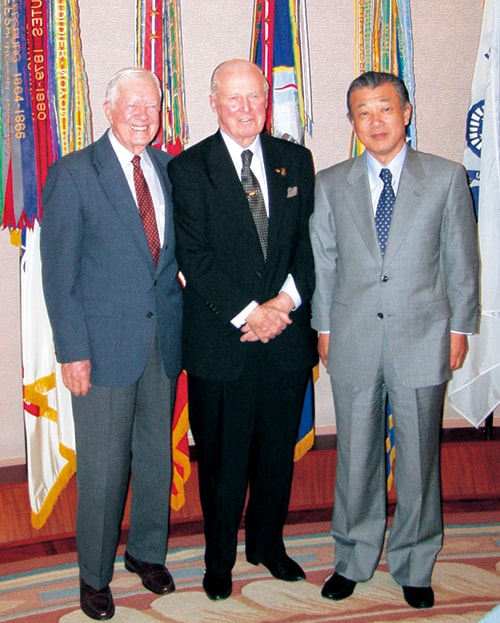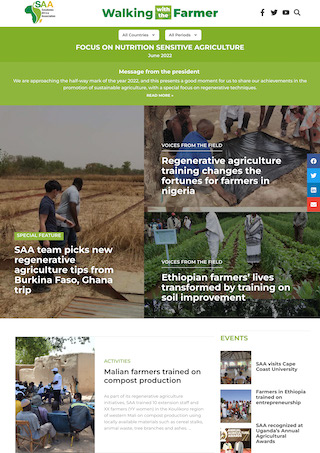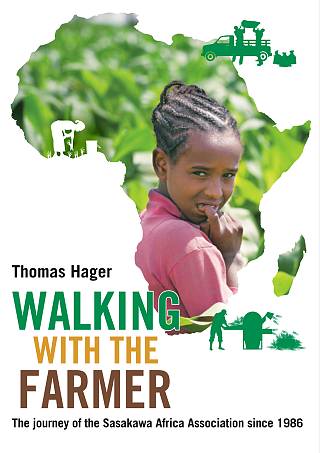SAA established in Geneva
In the late 1970s to early 80s, a number of African countries were struggling to cope with a worsening hunger situation – none more so than Ethiopia and the Horn of Africa countries which had suffered from the ravages of famine. The late Ryoichi Sasakawa, founder and former Chairman of The Nippon Foundation, was greatly moved by the ongoing tragedy, but he knew that food aid would not be a lasting or fundamental solution. So he contacted Dr. Norman Borlaug, who was awarded the Nobel Peace Prize for his contribution to food production enhancement in 1970, and former US President Jimmy Carter, to seek a more sustainable solution to Africa’s food security problems. Norman Borlaug’s dream was a green revolution in Africa, similar to the one he had created in the Indian sub-continent after successful research on higher-yielding maize and wheat varieties in Mexico. Ryoichi Sasakawa was prepared to fund the longer-term effort that would be needed. So, in 1986, the Sasakawa Africa Association (SAA) was registered as a not-for-profit international NGO in Geneva, Switzerland. The first programs were started in Ghana and Sudan.

Challenges for Food Production Enhancement in Africa
At the time, many experts agreed that the research-based technologies needed to increase food production were already available. The challenge was to get the right technologies into the hands of Africa’s rural smallholders, teach them how to use these technologies, and deliver them to more and more rural communities. The key to the solution was to establish an effective extension system to efficiently deliver improved technologies to farmers.
It was in this context that SAA dedicated itself to capacity building for public extension systems. Over time, SAA has worked with thousands of frontline extension agents (EAs) and millions of farmers in 15 African countries to promote the use of improved agricultural technologies, covering a wide range of staple crops from maize, wheat, rice, teff, sorghum, millet, legumes and to roots and tubers.
Target Countries
Between 1986 and the end of 2003, SAA operated in a total of 15 countries (Ghana, Sudan, Nigeria, Burkina Faso, Benin, Togo, Mali, Guinea, Zambia, Ethiopia, Eritrea, Tanzania, Uganda, Malawi and Mozambique).
In early 2004, the SAA Board of Directors decided to concentrate the organization’s human and financial resources on a smaller number of focus countries – Ethiopia, Mali, Nigeria and Uganda.
Early Efforts
SAA’s approach has always focused on demonstrating the potential of improved agricultural technologies to EAs and farmers through on-farm demonstration and training, from which EAs and farmers could assess the technologies by themselves. During the farming season, starting from land preparation, seeding, weeding to harvesting, farmers are able to observe the performances and cost-effectiveness of the technologies. Technical skills and knowledge include line planting, use of improved varieties, fertilizer application, and proper timing of the weeding and harvesting. These on-farm demonstration plots serve as useful platforms for EAs and farmers within a community, the members of which can see the effectiveness of the technology.
From 1986 to 2000, half a million large demonstration plots and several million smaller production test plots were established with strong financial contributions by the host governments where SAA worked.
Along with these demonstration programs, SAA supported promising innovations for raising and maintaining higher levels of soil productivity. A range of green manure crops was demonstrated including velvet bean (Mucuna), a remarkable Asian legume. Velvet bean is one of the few crops capable of recapturing fields from speargrass (Imperata cylindrica), an aggressive weed that blights vast expanses of cropland throughout the tropics. Velvet bean fixes nitrogen while growing, doubling its attractiveness to smallholder farmers. Cutting the plants and incorporating the vegetation into the soil allows them to use far less fertilizer for the following crop. In addition to green manure crops, SAA has promoted conservation tillage practices (minimum- or zero-tillage) where appropriate.
New Approaches and Priorities
In recent years, as the complexities and challenges of agriculture in Africa became better understood, many governments and development agencies have responded by broadening their areas of work. From 2004 to 2007, SAA reviewed its past effort, and revisited its strategy to bring impact with new priorities and areas of work. A broad consultative initiative began to take shape in 2007 and reached fruition with the introduction of Matrix Management by the end of 2009.
Still president of SAA during much of this period, Dr. Borlaug set the tone for the development of the new strategies. “We remain committed to working with public and private extension providers to ensure the delivery of much-needed technologies, knowledge and information to Africa’s resource-poor smallholder farmers,” he said, “but there are new priorities and new goals for us to attain…as we strive for that elusive Green Revolution in Africa.”
To achieve this, SAA has moved beyond crop production enhancement, covering postharvest handling, agro-processing, marketing and capacity building of farmer groups. Moreover, SAA has accelerated its efforts to encourage the participation of women farmers and youth groups in income-generation activities through service provision in the area of postharvest and agro-processing.
Now, the effort to address climate change is another critical issue for SAA’s strategy, through the identification and extension of climate-smart technologies, such as the introduction of drought-resistant varieties and early maturing varieties as well as water-harvesting.
SAA Publications

E-newsletter
"Walking with the Farmer"
SAA publishes a bimonthly e-newsletter reporting on SAA activities.

SAA history book
"Walking with the Farmer: The journey of the Sasakawa Africa Assoication since 1986"
This book chronicles the history of SAA from its inception to the present.

Annual Report
Annual Report FY2023
Annual Report FY2023 is available here.




